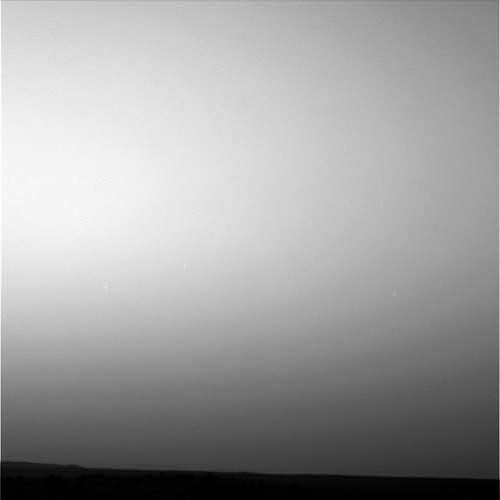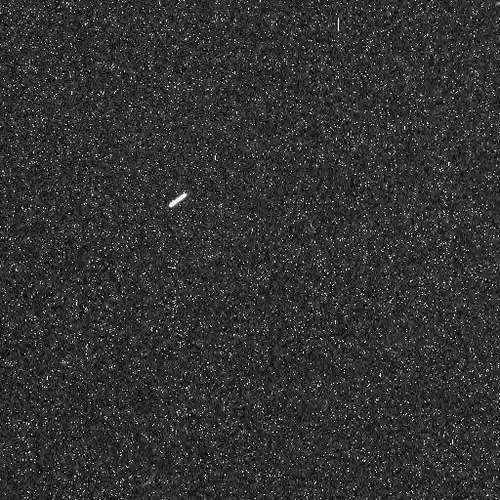[/caption]
When your rover has abundant energy but can’t go anywhere, what’s a scientist to do? How about making observations of the evening and night skies on Mars? With the benefit of a boost in electrical power from a wind gust cleaning off her solar panels, the Spirit rover has more energy available than she’s had for a couple of years. But unfortunately, Spirit is stuck in a patch of loose soil in the Home Plate region on Mars. While the engineers at JPL work hard at figuring out how to “Free Spirit” (see the new website dedicated to their efforts) scientists are making observations of her surroundings to aid in the effort to get her out. But there’s also enough power to do additional observations, and astronomy was a logical choice. “Certainly, a month or more ago, no one was considering astronomy with the rovers,” said Mark Lemmon, planetary scientist at Texas A&M University and member of the rover team. “We thought that was done. With the dust cleanings, though, everyone thinks it is better to use the new found energy on night time science than to just burn it with heaters.” Besides, Lemmon added, using all the energy in the daytime might lead to overheating.
The image above was taken on Spirit’s sol 1943 (June 22 on Earth)showing the night sky above her location.
But most of the “stars” in this raw image are not really stars, just hot pixels. “We use long and multiple exposures to make stars stand out,” Lemmon told Universe Today. “We can only see bright stars, looking through the dust, but can pick out most of the major stars in Orion for instance.”
But a star is visible in this image. “That streak in the 1943 images is the bright star Canopus,” said Jim Bell, planetary scientist at Cornell University and lead for the rovers’ Pancam team. “We’re monitoring stars to search for evidence of night-time clouds, fog, and hazes. We’re also occasionally trying to image Earth and Venus as they set in the west after sunset. We’ve had some success, but the twilight sky is so bright we’re still working on tweaking the exposure times.”
Of course, this isn’t the first time Spirit has done astronomy on Mars. She also made night sky observations back in 2005. In an article Bell wrote for Sky and Telescope in 2006 he described Spirit’s astronomy as “stone-knives and bear-skins backyard astronomy–but from Mars!” And certainly, this is exciting to have an additional opportunity to make astronomical observations from the surface of another world.

Bell added that the current astronomy campaign with Spirit has many similarities with the one four years ago, and Lemmon said they are focusing on a few different goals for looking at the twilight and night skies.
“The Canopus images may become a regular occurrence, as a way to monitor dust and/or ice in the sky at night–much as we use Sun images in the day,” Lemmon said. “For something like that, we can pick an aim (Canopus, Orion, etc.) and choose filters. We might use color filters to look for any differences that show up, or the clear filter for the most sensitive measurement. Star exposures can go up to 5.5 minutes (compare to 0.1-0.5 sec for a normal day image). We cannot track stars, so they trail after 10 seconds or so–as you see Canopus doing. In longer exposures, hot pixels and cosmic rays show up as points or cluster of light.”
Lemmon said attempting to image Earth and Venus has been challenging. “We’ve imaged both before, farther from the Sun. They are in the twilight, limiting the exposure we can use, and they are in a “bright” part of the sky.”
Lemmon added his personal favorite right now is actually the twilight imaging — not looking at stars but at how fast the twilight glow fades after sunset. “That is proving to be quite helpful in terms of understanding the distribution of dust in the atmosphere –which is closely tied to how weather works on Mars,” he said.
In 2005, the Pancam team was able to capture images of Mars’ two moons, Phobos and Deimos. “They are much brighter and let us use more filters if desired. We may pick this up again. I’m a fan of eclipse imaging, so we would need several quick images to see how fast the moon fades as sunlight is blocked by dust around Mars.”
The moons should start becoming more visible soon, and Lemmon said they will continue to take more images of Canopus and maybe other star fields. The team is not specifically looking for meteors or the orbiters around Mars, but there’s always the prospect of something fascinating showing up on future images.
“We’ve taken some recent images I hope will have new, interesting things in them,” Lemmon said. “But they are still on board the rover so we’ll have to wait and see what they show later.”
Stay tuned!
Webpage on Spirit’s 2005 astronomical imaging.
Sources: email exchanges with Mark Lemmon and Jim Bell


God, how I love those little machines.
I’d like some color images or a panorama at twilight.